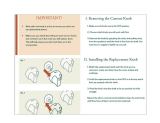
CHECK DAMAGED PARTS. Check for:
• Alignment of moving parts.
• Binding of moving parts.
• Broken pads.
• Stable mounting.
• Any other conditions that may affect the way
the saw works.
If any part is missing, bent or broken in any way,
or any electrical parts don't work properly, turn the
saw off and unplug the saw. REPLACE damaged,
missing or failed parts before using the saw again.
KEEP GUARD IN PLACE and in working order.
MAINTAIN TOOLS WITH CARE. Keep the saw
clean for best and safest pedormance. Follow
instructions for lubricating.
REMOVE ADJUSTING KEYS AND WRENCHES
from tool before turning it on.
To avoid injury from jams, slips or thrown
pieces:
• Choose the right size and style blade for the
material and the type of cutting you plan to do.
• USE ONLY RECOMMENDED ACCESSORIES.
(See page 19). Consult this owneCs manual for
recommended accessories. Follow the instruc-
tions that come with the accessories. The use of
improper accessories may cause risk of injury to
person.
• Make sure the blade teeth point downward,
toward the table.
o Make sure the blade tension is propedy adjusted.
° Make sure the bevel lock knob is tight and no
parts have excessive play,
, To avoid accidental blade contact, minimize blade
breakage and provide maximum blade support,
always adjust the blade hold down and blade
guard to just clear the workpiece.
. KEEP WORK AREA CLEAN. Cluttered areas
and benches invite accidents. Floor must not be
slippery.
To avoid burns or other fire damage, never use the
saw near flammable liquids, vapors or gases.
PLAN AHEAD TO PROTECT YOUR EYES,
HANDS, FACE, EARS.
KNOW YOUR SAW. Read and understand the
owner's manual and labels affixed to the tool. Learn
its application and limitations as well as the specific
potential hazards peculiar to this tool.
To avoid injury from accidental contact with moving
parts, don't do layout, assembly, or setup work on
the saw while any parts are moving.
AVOID ACCIDENTAL STARTING. Make sure switch
is "OFF" before plugging saw into a power outlet.
Plan your work.
. USE THE RIGHT TOOL. Don't force tool or
attachment to do a job it was not designed 1o do.
3
• Use this scroll saw to cut only wood, woodqike
products, plastics and nomferrous metals.
CAUTION: This saw is NOT designed for
cutting ferrous metals like iron or steel. When
cutting non-ferrous metals (brass, copper and
aluminum, etc.), metal shavings can react with
wood dust and start a fire. To avoid this:
° Disconnect any type of dust collecting
hose from the saw.
• Remove all traces of wood dust
from on and around the saw.
• Remove a,tl meta! shavings from on
or around the saw before sawing
wood again.
Dress for safety.
WEAR YOUR
Any power saw can throw foreign objects into the
eyes. This can cause permanent eye damage. Wear
safety goggles (not gtasses) that comply with
ANSI Z87_1 (shown on package). Everyday
eyeglasses have only impact resistant lenses. They
are not safety glasses. Safety goggles are available
at Sears Retail or Catalog Stores. Glasses or
goggles not in compliance with ANSI Z87.1 could
seriously hurt you when they break.
• Do not wear loose clothing, gloves, neckties or
jewelry (rings, wristwatches), They can get
caught and draw you into moving parts.
• Wear nonstip footwear.
• Tie back long hair.
• Roll long sleeves above the elbow.
• Noise levels vary widely. To avoid possible
hearing damage, wear ear plugs or muffs when
using saw for hours at a lime.
• For dusty operations, wear a dust mask along
with the safety goggles.
Inspect your workpiece.
Make sure there are no nails or foreign objects in
the par1 of the workpiece to be cut.
Use extra caution with large, very small or
awkward workpieces:
• Never use this toot to finish pieces too smatl to
hold by hand.
Use extra supports (tables, saw horses, blocks,
etc.) for any workpieces large enough to tip
when not held down to the table top.
NEVER use another person as a substitute for a
tabte extension, or as additionaf support for a
workpiece or to help 1eed supporl or puli the
workpiece.




















